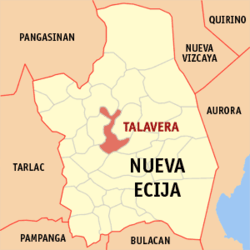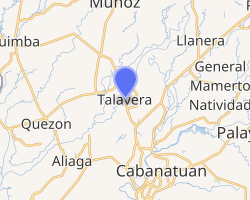Talavera, Nueva Ecija
Talavera, officially the Municipality of Talavera (Filipino: Bayan ng Talavera), is a 1st class municipality [5] in the province of Nueva Ecija, Philippines. According to the 2015 census, it has a population of 124,829 people.[3]
Talavera Katuigan | |
|---|---|
| Municipality of Talavera | |
Downtown | |
 Seal | |
| Nickname(s): Talavera of the Crown of the Princess | |
| Motto(s): Sa Talavera...Todo Asenso Bayan at Tao | |
 Map of Nueva Ecija with Talavera highlighted | |
OpenStreetMap 
| |
.svg.png) Talavera Location within the Philippines | |
| Coordinates: 15°35′02″N 120°55′08″E | |
| Country | |
| Region | Central Luzon (Region III) |
| Province | Nueva Ecija |
| District | 1st District |
| Founded | 1872 |
| Barangays | 53 (see Barangays) |
| Government | |
| • Type | Sangguniang Bayan |
| • Mayor | Nerivi S. Santos-Martinez |
| • Vice Mayor | Anselmo B. Rodiel III |
| • Congressman | Estrellita B. Suansing |
| • Councilor | Members
|
| • Electorate | 82,836 voters (2019) |
| Area | |
| • Total | 140.92 km2 (54.41 sq mi) |
| Population (2015 census)[3] | |
| • Total | 124,829 |
| • Density | 890/km2 (2,300/sq mi) |
| • Households | 27,987 |
| Economy | |
| • Income class | 1st municipal income class |
| • Poverty incidence | 13.02% (2015)[4] |
| • Revenue (₱) | 249,570,593.91 (2016) |
| Time zone | UTC+8 (PST) |
| ZIP code | 3114 |
| PSGC | |
| IDD : area code | +63 (0)44 |
| Climate type | tropical monsoon climate |
| Native languages | Ilocano Tagalog |
| Website | www |
Talavera is part of Cabanatuan conurbation as adjacent urban center in the heart of Nueva Ecija. It is dubbed as the "Milk Capital" and "Food basket in Inland Luzon"
Talavera is one of the fastest growing municipalities in the province and proposals have been planned for cityhood. Given its robust economic growth, Talavera enjoys annual progress and wealth. The town's revenue-generated income as of 2017 is P298,361,401.93 and with over 124,829 inhabitants, the town meets the requirements for cityhood.[6] In July 2019, Congresswoman Estrellita B. Suansing has filed House Bill 184, regarding the cityhood of Talavera.
According to the National Competitiveness Council in Cities/Municipalities Competitiveness Index, during the past years, Talavera maintained their rankings as one of the most competitive municipalities in the Philippines.
It is bordered by Cabanatuan, Llanera, Muñoz, Aliaga, General Mamerto Natividad, Santo Domingo and San Jose.
History
Present-day Talavera was formerly a barrio of Cabanatuan City. It was called “Katugian” which means a place abundant in “Tugue,” an edible root crop.
The distance between Cabanatuan's town center and Katugian was critical during the early phase of its development although it was only 15 kilometres (9.3 mi). The parish-curate at that time recommended to the Spanish administrators a separate and independent administration of Katugian.
By a royal decree issued on November 12, 1852, the plan making Katugian a town was approved. There was no formal inauguration of the new town in accordance with the royal decree. However, the Augustinian parish-curate of Cabanatuan, Fr. Gregorio Crisostomo, appointed the first officials of the town by sending his co-adjutor, a certain Pedro Estanislao Pascual, to handle the religious phase of the administration of the new town during Sundays and Holidays only.
The first barrios that composed the new town were La Torre, Pulong Buli (Now Santo Domingo), Concepcion and Valle. Based on the petition presented to the Alcalde Mayor (governor) of Nueva Ecija, forwarded to the governor general in Manila, the “Talavera of the Crown of the Princess” was approved on February 17, 1853, by the Governor General.
In 1954, Talavera lost some territory when the barrios of General Luna, Morcon, Mabini, Ricarte, Casili, and Picon, together with sitios Plaridel and Bosque were separated to form the town of Llanera along with some territory from Rizal and San Jose.[7]
Topography
The municipality's terrain is relatively flat, with slope ranging from 0 to 3%. Due to the flat topography, the land is suited for agricultural, commercial or industrial development.
Barangays
Talavera is politically subdivided into 53 barangays.
- Andal Aliño
- Bagong Sikat
- Bagong Silang
- Bacal I
- Bacal II
- Bacal III
- Baluga
- Bantug
- Bantug Hacienda
- Basang Hamog
- Bugtong na Buli
- Bulac
- Burnay
- Calipahan
- Campos
- Casulucan Este
- Collado
- Dimasalang Norte
- Dimasalang Sur
- Dinarayat
- Esguerra District
- Gulod
- Homestead I
- Homestead II
- Cabubulaunan
- Caaniplahan
- Caputican
- Kinalanguyan
- La Torre
- Lomboy
- Mabuhay
- Maestrang Kikay (Poblacion)
- Mamandil
- Marcos District (Poblacion)
- Matias District(Poblacion)
- Matingkis
- Minabuyoc
- Pag-asa District (Poblacion)
- Paludpod
- Pantoc Bulac
- Pinagpanaan
- Poblacion Sur (Poblacion)
- Pula
- Pulong San Miguel
- Sampaloc
- San Miguel na Munti
- San Pascual
- San Ricardo
- Sibul
- Sicsican Matanda
- Tabacao
- Tagaytay
- Valle
There is a moved to include the Barangay Matingkis (Talavera) Bakal 1, Bakal 2 and Bakal 3 to become part of Science City of Munoz which is part of the jurisdiction of the Municipality of Talavera for the reason that the said barangays are geographically and strategically within the Science City of Munoz.
This was favored by most of the residents of the said barangays but opposed by the Municipal Government of Talavera. The National Government has an ongoing move to transfer the said barangay to the Science City of Munoz. }}
Climate
| Climate data for Talavera, Nueva Ecija | |||||||||||||
|---|---|---|---|---|---|---|---|---|---|---|---|---|---|
| Month | Jan | Feb | Mar | Apr | May | Jun | Jul | Aug | Sep | Oct | Nov | Dec | Year |
| Average high °C (°F) | 29 (84) |
30 (86) |
32 (90) |
34 (93) |
33 (91) |
31 (88) |
30 (86) |
29 (84) |
29 (84) |
30 (86) |
30 (86) |
29 (84) |
31 (87) |
| Average low °C (°F) | 19 (66) |
19 (66) |
20 (68) |
22 (72) |
24 (75) |
24 (75) |
24 (75) |
24 (75) |
23 (73) |
22 (72) |
21 (70) |
20 (68) |
22 (71) |
| Average precipitation mm (inches) | 4 (0.2) |
6 (0.2) |
7 (0.3) |
12 (0.5) |
61 (2.4) |
89 (3.5) |
96 (3.8) |
99 (3.9) |
81 (3.2) |
88 (3.5) |
37 (1.5) |
13 (0.5) |
593 (23.5) |
| Average rainy days | 2.5 | 3.0 | 4.1 | 6.3 | 15.8 | 19.4 | 22.5 | 21.6 | 20.1 | 17.5 | 9.6 | 4.0 | 146.4 |
| Source: Meteoblue [8] | |||||||||||||
Demographics
|
| ||||||||||||||||||||||||||||||||||||||||||||||||
| Source: Philippine Statistics Authority[3][9][10][11] | |||||||||||||||||||||||||||||||||||||||||||||||||
Religion
Majority of Talavera's populace is Roman Catholic, served by St. Isidore the Worker Parish Church (Paroquia de San Isidro Labrador) and chapels in other barangays. Other religious groups have churches and places of worship in the municipality.
Economy
Talavera's economy focus on the agricultural sector. Palay, onions, and calamansi are their main crops. However, making it progress, economically developed andsprouting business establishment in their poblacion areas are currently addressed the town more productive and sustainable.
Many government projects beneficial to the municipality's citizens were constructed, including the Nueva Ecija University of Science and Technology—Municipal Government of Talavera(NEUST–MGT), an extension campus of the said university; Talavera Eternal Park, the municipality's cemetery; a town library, and government-run drugstore.
Tourist attractions in Talavera are as follows:
- Town Plaza
- Tren ng Bayan
- Crystal Wave Hotel and Resort
- DVF Dairy Farm
- Isdaan Floating Restaurant
Festival
Gatas ng Kalabaw Festival
Carabao's milk festival also known as Gatas ng Kalabaw festival is celebrated annually starting May 12–15; including feast of the patron Saint Isidore. The festival aims to actively encourage, promote and enhance carabao's milk as a nutrition and livelihood industry. Highlights of the festival are street dancing, followed by float parade, parade of carabaos, carabao race, agri-trade fair, milk drinking contest and ice cream making competition among others.[12]
Semana Santa sa Talavera
During the Holy Week, the members of the church (San Isidro Labrador Parish Church) commemorates Jesus' Paschal mystery. The church even has a community where each member owns a religious image called the Cofradia de la Sagrado Pasion del Nuestro Señor. Every Holy Wednesdays and Good Fridays, the members of the Cofradia places the images of their saints in carozzas or karo and exhibits it for the townspeople to witness thru a procession.
Transportation
There are 24.77 kilometres (15.39 mi) of national roads, including the 16.93 kilometres (10.52 mi) Maharlika Highway/Asian Highway 26 that passes through the municipality. Due to its central location, the Municipality of Talavera is one of the pivotal transport points in Central Luzon.
Talavera is accessible by all means of land transportation. Regular jeepney trips are from 5:00 am to 9:00 pm. Tricycles are available 24 hours a day. Several bus companies also use the Talavera route from Cagayan Valley and Aurora Province to Manila, Cabanatuan City, San Jose City, Baguio City and other destinations.
Health
Talavera's populace is served by Talavera General Hospital a National Government Financed Hospital formerly known as Dr. Paulino J. Garcia Memorial Hospital- Talavera Extension Program. Medical and dental clinics also serve the municipality.
Education
Talavera is served by both public and Departmet of Education-accredited private schools. The largest elementary school is Talavera Central School, also known as Central, which is situated at the town proper. The largest secondary educational institution is Talavera National High School, colloquially knows as TNHS.
University and colleges:
- Nueva Ecija University of Science and Technology - Talavera Academic Extension Campus
- La Fortuna College - Talavera Campus
- REH Montessori College
- St. Elizabeth Global College
Images
- Ricefields
- Governor Umali covered courts, gymnasium
References
- "Municipality". Quezon City, Philippines: Department of the Interior and Local Government. Retrieved 31 May 2013.
- "Province: Nueva Ecija". PSGC Interactive. Quezon City, Philippines: Philippine Statistics Authority. Retrieved 12 November 2016.
- Census of Population (2015). "Region III (Central Luzon)". Total Population by Province, City, Municipality and Barangay. PSA. Retrieved 20 June 2016.
- "PSA releases the 2015 Municipal and City Level Poverty Estimates". Quezon City, Philippines. Retrieved 1 January 2020.
- "Cities and Municipalities urban population". City population. Retrieved 28 October 2018.
- "Annual Audit Report". Commission on Audit. Retrieved 19 October 2018.
- "An Act to Create the Municipality of Llanera in the Province of Nueva Ecija". LawPH.com. Retrieved 2011-04-11.
- "Talavera: Average Temperatures and Rainfall". Meteoblue. Retrieved 4 May 2020.
- Census of Population and Housing (2010). "Region III (Central Luzon)". Total Population by Province, City, Municipality and Barangay. NSO. Retrieved 29 June 2016.
- Censuses of Population (1903–2007). "Region III (Central Luzon)". Table 1. Population Enumerated in Various Censuses by Province/Highly Urbanized City: 1903 to 2007. NSO.
- "Province of Nueva Ecija". Municipality Population Data. Local Water Utilities Administration Research Division. Retrieved 17 December 2016.
- "The Ultimate travel guide for tourist". Department of Tourism. Retrieved 19 October 2018.
External links
| Wikimedia Commons has media related to Talavera, Nueva Ecija. |